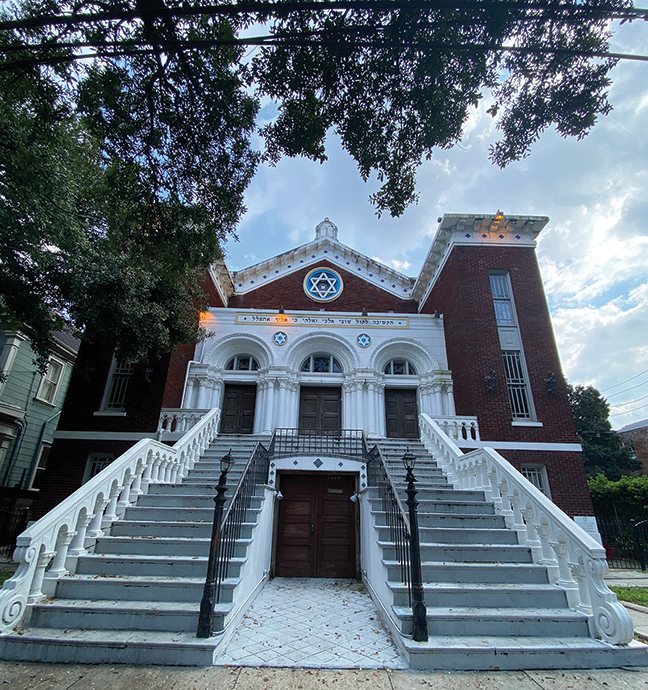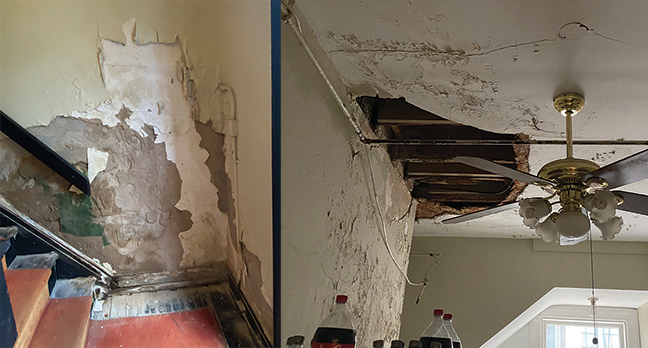Approaching building’s centennial, Nola landmark Anshe Sfard launches capital campaign

A century ago, the thriving Orthodox community in New Orleans was centered around several blocks of Dryades Street. With the community long ago moving on to other parts of town, the small congregation of Anshe Sfard is the last functioning reminder of those times still in the area — and its historic building is about to turn 100.
Rabbi Yochanan Rivkin, who has served at Anshe Sfard since 2016 in addition to being the director of Chabad at Tulane, wants to see Anshe Sfard have many more years of service to the community — but as the anniversary approaches, it will need help to do so.
The congregation has kicked off “Another 100 Years for Anshe Sfard,” to address “critical” needs that have built up over the years.
Because of a lack of resources, “the shul has not really been maintained for the last 30 years,” Rivkin explained. There is a lot of deferred maintenance that has built up, and some interior spaces are currently not usable.
Currently, he said, “there’s basically a sanctuary upstairs and a big social hall downstairs.” To bring in families, he said there needs to be classroom space and a play area.

To get to the upstairs sanctuary, one either goes up the outdoor steps or the one narrow inside staircase, so accessibility will need to be examined.
As is typical for buildings from that era, there has been a lot of water intrusion and “the plaster is constantly shedding,” and many other places in the building need basic repair. The electrical system is “way out of date,” which could affect the building’s insurability in the future.
He noted that the office is “in complete disrepair” and not usable, a room that is supposed to be a library and small chapel is instead a storage area, and the kitchen is old and needs to be upgraded — not to mention a large hole in the ceiling. And in these times, security upgrades are also essential.
“These are all things we need to have in place when you think about a thriving congregation,” Rivkin said.

The campaign will address years of “deferred maintenance”
The campaign, which will take place over the next two years, has a goal of $2 million. “If we raise half of our goal, we can save the building and continue operating,” Rivkin said. “If we want to grow and thrive, we need to get to the full goal.”
They hope to be able to start working in a few months.
“Let’s try to raise as much as we can,” Rivkin said. “It really needs to be brought back to its former glory.”
Historic building
The building was designed by noted architect Emile Weil in the Italian Renaissance style, with Moorish and Byzantine decorative details. Weil also designed the current Touro Synagogue building and the 1924 Beth Israel building, also on Carondelet.
Among Weil’s other buildings were the Kress Department Store, Dixie Brewery, Whitney National Bank and the Jerusalem Temple of the Shriners. He also designed the Saenger Theatres in New Orleans, Mobile, Hattiesburg, Pensacola and several other cities, and the Temple Theater in Meridian.
Dedications for the Anshe Sfard renovations start with the building name, and also include the Torah study and resource library, indoor play zone, sunshine playground, rabbi’s study, the Shalom Hall entry, the grand stairway, the front doors, the sukkah pavilion, the foundation entrance, and mezuzahs. Additional opportunities include the sanctuary name, ark, women’s gallery, bima, community social hall, Southern Jewish Heart kitchen, and a new “Sip and Schmooze” station.
New Orleans had a long-established Reform community when a large wave of immigration from Eastern Europe began in the late 1800s. As was the case around the country, there was a social and religious divide between the established American Jews from places like France and Germany, and the much more traditional newcomers, who kept kosher, spoke Yiddish and were unaccustomed to the more Americanized Reform services.
The new community quickly centered on Dryades Street, from Howard to Jackson Avenue. Several small congregations were established, generally conforming to a certain place of origin. Tememe Derech was formed in 1857 by Polish Jews. Chevra Thilim was Galitzianer, founded in 1875, and Mikvah Israel was a small Litvak congregation.
In 1896, a Lithuanian group started meeting under the name of Anshe Sfard, and was chartered in October 1900. That year, the group purchased a small building at 1309 South Rampart. In 1925, they purchased their current site on Carondelet, and the current building was completed in 1926.
The 1998 New Orleans Landmark Designation report notes that while the congregation’s name means United Brotherhood of the Sephardic Rite, “this congregation, however, was Eastern European and Orthodox. At no time have they considered themselves Sephardic,” yet they followed Sephardic rites.
In 2017, the building was added to the National Register of Historic Places.
Many of the other small congregations in the neighborhood merged in 1904 to form Beth Israel, which moved into a new facility two years later, with the assistance of the Reform community. They would replace that structure in 1924 with a large building that seats 1200, and added an educational arm nearby, the Menorah Institute. The 1924 Beth Israel building is now New Home Ministries, with that stretch of Carondelet renamed in memory of their former pastor, Robert C. Blakes.
Chevra Thilim, which would later be one of the congregations to form Shir Chadash, built a small synagogue in 1915. As the next generations moved to other neighborhoods, Chevra Thilim moved Uptown in 1948 while Beth Israel moved to Lakeview in 1971, leaving Anshe Sfard as the sole congregation in the historic neighborhood.
As the closest congregation to downtown, Anshe Sfard is often a stop for tourists or those attending conventions, especially those looking for a traditional service or needing something within walking distance.
With Rivkin’s work at Tulane, Anshe Sfard is often a spot for Chabad at Tulane programming. Recently, a monthly Holy Happy Hour was inaugurated, with Shabbat evening services and a happy hour.
In the 2012 film “The Campaign,” starring Will Ferrell and Zach Galifianakis, Anshe Sfard was the setting for a scene involving going after the Jewish vote.



